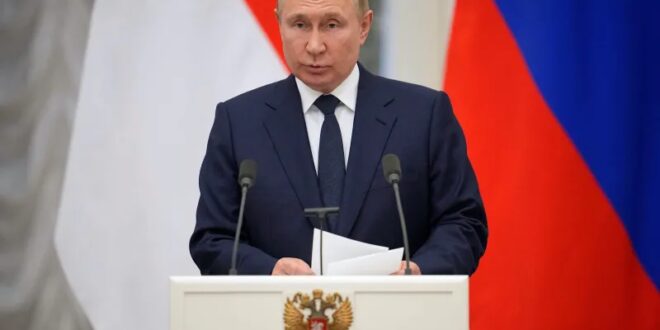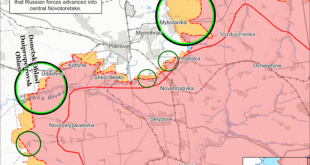What Happens If Putin Goes Nuclear?
As the war in Ukraine rages on, Russian President Vladimir Putin has engaged in nuclear saber rattling. “Whoever tries to impede us, let alone create threats for our country and its people, must know that the Russian response will be immediate and lead to the consequences you have never seen in history,” Putin declared in February in the first of many statements warning of a potential nuclear strike. For the most part, Western observers have dismissed this talk as idle chest-thumping. After all, whichever side fired nuclear weapons first would be taking a very risky gamble: betting that its opponent would not retaliate in an equal or more damaging way. That is why the odds are very low that sane leaders would actually start a process of trading blows that could end in the destruction of their own countries. When it comes to nuclear weapons, however, very low odds are not good enough.
Planning for the potential that Russia would use nuclear weapons is imperative; the danger would be greatest if the war were to turn decisively in Ukraine’s favor. That is the only situation in which the Russians’ incentive to take that awesome risk would be plausible, in an attempt to prevent defeat by shocking Ukraine and its NATO supporters into standing down. The Russians might do this by setting off one or a few tactical nuclear weapons against Ukrainian forces or by triggering a symbolic explosion over an empty area.
There are three general options within which U.S. policymakers would find a variation to respond to a Russian nuclear attack against Ukraine. The United States could opt to rhetorically decry a nuclear detonation but do nothing militarily. It could unleash nuclear weapons of its own. Or it could refrain from a nuclear counterattack but enter the war directly with large-scale conventional airstrikes and the mobilization of ground forces. All those alternatives are bad because no low-risk options exist for coping with the end of the nuclear taboo. A conventional war response is the least bad of the three because it avoids the higher risks of either the weaker or the stronger options.
COMPETITION IN RISK
For the past three decades, U.S. policymakers have paid scant attention to the potential dynamics of nuclear escalation. During the Cold War, in contrast, the question was at the center of strategic debate. Back then, it was NATO that relied in principle on the option of deliberate escalation—beginning with the limited use of tactical nuclear weapons—as a way to halt a Soviet invasion. This strategy was controversial, but it was adopted because the West believed its conventional forces to be inferior to the Warsaw Pact’s. Today, with the balance of forces reversed since the Cold War, the current Russian doctrine of “escalate to deescalate” mimics NATO’s Cold War “flexible response” concept.
NATO promoted the policy of flexible response rhetorically, but the idea was always shaky strategically. The actual contingency plans it generated never commanded consensus simply because initiating the use of nuclear weapons risked tit-for-tat exchanges that could culminate in an apocalyptic unlimited war. As J. Michael Legge, a former participant in NATO’s Nuclear Planning Group, noted in a 1983 study for the RAND Corporation, the group could not reach agreement on specific follow-on options beyond an initial symbolic “demonstration shot” for psychological effect, for fear that Moscow could always match them or up the ante. Today, it is hoped that this old dilemma will deter Moscow from unleashing the nuclear genie in the first place.
But NATO policymakers should not bank on Moscow’s restraint. Putin has more at stake in the war than Ukraine’s nuclear-armed supporters outside the country do, and he could bet that in a pinch, Washington would be less willing to play Russian roulette than he is. He could play the madman and apply nuclear shock as an acceptable risk for ending the war on Russian terms.
LEVELS OF ESCALATION
As NATO confronts the possibility of Russia using nuclear weapons, the first question it needs to answer is whether that eventuality should constitute a real redline for the West. In other words, would a Russian nuclear attack trigger NATO’s shift from merely supplying Ukraine to engaging directly in combat itself? A Russian rationale for tactical nuclear weapons use would be as much to frighten NATO away from crossing that line as to coerce Ukraine into surrender. If a few Russian nuclear weapons do not provoke the United States into direct combat, Moscow will have a green light to use even more such weapons and crush Ukraine quickly.
If the challenge that is now only hypothetical actually arrives, entering a nuclearized war could easily strike Americans as an experiment they do not want to run. For that reason, there is a very real possibility that policymakers would wind up with the weakest option: rant about the unthinkable barbarity of the Russian action and implement whatever unused economic sanctions are still available but do nothing militarily. This would signal that Moscow has complete freedom of action militarily, including the further use of nuclear weapons to wipe out Ukrainian defenses, essentially conceding a Russian victory. As dishonorable as submission sounds to hawks in advance, if the time actually comes, it will have the strong appeal to Americans, because it would avoid the ultimate risk of national suicide.
A nuclearized war could easily strike Americans as an experiment they do not want to run.
That immediate appeal has to be balanced by the longer-term risks that would balloon from setting the epochal precedent that initiating a nuclear attack pays off. If the West is not to back away—or, more important, if it wants to deter Putin from the nuclear gambit in the first place—governments need to indicate as credibly as possible that Russian nuclear use would provoke NATO, not cow it.
If NATO decides it would strike back on Ukraine’s behalf, then more questions arise: whether to also fire nuclear weapons and, if so, how. The most prevalent notion is an eye-for-an-eye nuclear counterattack destroying Russian targets comparable to the ones the original Russian attack had hit. This is the option that occurs intuitively, but it is unattractive because it invites slow-motion exchanges in which neither side gives up and both ultimately end up devastated.
Alternatively, Washington could respond with nuclear strikes on a larger scale than the Russian first use, threatening disproportionate losses to Moscow if it tries further limited nuclear attacks. There are several problems with this heftier option. For one, if used against Russian forces inside Ukraine, U.S. nuclear weapons would inflict collateral damage on its own clients. This is not a new problem. During the Cold War, strategists critical of relying on tactical nuclear weapons to counter invading Soviet forces quipped, “In Germany, the towns are only two kilotons apart.” Using nuclear weapons instead against targets inside Russia would intensify the danger of triggering unlimited war.
A second problem with back-and-forth tactical nuclear shots is that Russia would be at an advantage because it possesses more tactical nuclear weapons than the United States does. That asymmetry would require U.S. policymakers to resort sooner to so-called strategic forces (intercontinental missiles or bombers) to keep the upper hand. That, in turn, would risk unleashing the all-out mutual destruction of the major powers’ homelands. Thus, both the tit-for-tat and the disproportionate retaliatory options pose dauntingly high risks.
A less dangerous option would be to respond to a nuclear attack by launching an air campaign with conventional munitions alone against Russian military targets and mobilizing ground forces for potential deployment into the battle in Ukraine. This would be coupled with two strong public declarations. First, to dampen views of this low-level option as weak, NATO policymakers would emphasize that modern precision technology makes tactical nuclear weapons unnecessary for effectively striking targets that used to be considered vulnerable only to undiscriminating weapons of mass destruction. That would frame Russia’s resort to nuclear strikes as further evidence not only of its barbarism but of its military backwardness. Direct entry into the war at the conventional level would not neutralize panic in the West. But it would mean that Russia would be faced with the prospect of combat against a NATO that was substantially superior in nonnuclear forces, backed by a nuclear retaliatory capability, and less likely to remain restrained if Russia turned its nuclear strikes against U.S. rather than Ukrainian forces. The second important message to emphasize would be that any subsequent Russian nuclear use would trigger American nuclear retaliation.
This conventional option is hardly attractive. Direct war between the major powers that starts at any level risks escalation to mass destruction. Such a strategy would appear weaker than retaliation in kind and would worsen the Russians’ desperation about losing rather than relieve it, thus leaving their original motive for escalation in place along with the possibility that they would double down and use even more nuclear weapons. That would make it imperative to couple the NATO military response with an offer of settlement terms that includes as many cosmetic concessions as possible to give Russia some pretense of peace with honor. The main virtue of the conventional option is simply that it would not be as risky as either the weaker do-nothing or the stronger nuclear options.
THE WEST’S DILEMMA
In the event of a Russian nuclear detonation, NATO will have two conflicting aims. On the one hand, the alliance will want to negate any strategic benefit Moscow could gain from the detonation; on the other, it will want to avoid further escalation. This dilemma underlines the obvious imperative of maximizing Moscow’s disincentives to go nuclear in the first place.
To that end, NATO should not only pose credible threats of retaliation but also cultivate support from third parties that Putin wants to keep from joining the Western opposition. So far, Moscow has been buoyed by the refusal of China, India, and other countries to fully join the economic sanctions campaign imposed by the West. These fence sitters, however, have a stake in maintaining the nuclear taboo. They might be persuaded to declare that their continued economic collaboration with Russia is contingent on it refraining from the use of nuclear weapons. As a declaration about a still hypothetical eventuality, the neutral countries could see this as a low-cost gesture, a way to keep the West off their backs by addressing a situation they don’t expect to occur.
Washington will always keep declared threats and strategy vague enough to provide flexibility and escape hatches. Still, any further nuclear saber rattling by Putin should prompt simple but forceful reminders from Washington of what Putin knows but might otherwise convince himself the West has forgotten: Russia is utterly vulnerable to nuclear retaliation, and as generations of thinkers and practitioners on both sides have reiterated, a nuclear war has no winner.
 Eurasia Press & News
Eurasia Press & News

